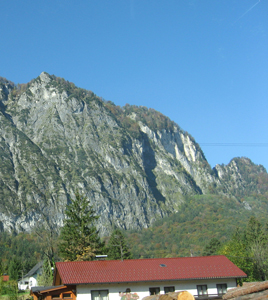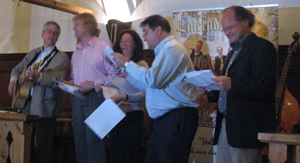The Green Solvents for Synthesis conference started on Sunday the 10th October 2010 with a boat trip on Lake Königsee which I was told was absolutely spectacular with plenty of mountain landscape. The lake was described as the purest of all “green solvents” being a gorgeous emerald green in colour.
The delegates were then gathered for a welcome reception in the evening and an opening lecture delivered by Phil Jessop (Queen’s University, Canada) where he described the progress made in green solvents and categorised them in three areas: Replacement green solvents, Really green solvents, and Revolutionary green solvents. His comments were that the replacement solvents may not be enough to cover the different needs. Some solvents have been assessed thoroughly and found to be really green, but most “green” solvents have not been assessed.
On the first day of the conference, Peter Dunn of Pfizer Ltd gave us a broad overview of organic reactions carried out in water. Other talks of interest were by Takao Ikariya (Tokyo institute of Technology) on the use carbon dioxide as green solvent and reactant for organic reactions and Tadafumi Adschiri (Tohoku University) who brought along samples of the super hybrid materials made in his lab via supercritical routes. This was followed by a lecture by Andreas Jess (University of Bayreuth, Germany) on the evaporation and thermal decomposition of ionic liquids by thermogravimetry at ambient pressure and UHV. The afternoon ended with an inspiring lecture by Peter Wassercheid (University of Erlangen-Nuremberg) on ionic liquids and heterogeneous catalysis and his recent progress on supported ionic liquid phase (SILP) and supported catalyst with an ionic liquid layer (SCILL). A poster session then followed with winners to be announced shortly.
The highlights of the second day were talks by Dieter Vogt (TU Eindhoven) on homogeneous catalysis and amine formations, followed by Alberto Puga (QUILL, Belfast) on new 6-membered piperidine and 7-membered azepane derived ionic liquids. It became clear that toxicity is an important factor in determining the “greenness” of new ionic liquids. Other talks of interest were algae lipids for biodiesel production delivered by Lindsay Soh (PhD student at Yale University) and fluorous solvents for catalyst recovery, activation and product protection given by John Gladysz (Texas A&M University).
The delegates were spoilt for choices for lunch at either traditional Bavarian style restaurants or small cafes with plenty of outdoor seating to soak up the sun and the magnificent mountain views. The afternoon session resumed with an awe-inspiring talk by Steve Howdle (University of Nottingham, UK) where he used supercritical fluids to synthesize green polymers which were used in bone grafting and drug delivery. We later learnt that Steve, who is a keen footballer, had been invited to take a penalty shoot at half-time during the England-Montenegro qualifying match at Wembley Stadium and he had declined the FA invitation to be with us at the Green Solvents conference. Biocatalysis was also on the agenda with a talk from Udo Kragl (University of Rostock, Germany).
The day ended with a traditional Bavarian buffet and music. The atmosphere was light-hearted and spirits high. Walter Leitner, Steve Howdle, Istvan Horvath, Peter Wassercheid and Helen Olivier-Bourbigou grouped on stage for an excellent rendition of the “green chemistry song”, lyrics below:
Always Use Green Chemistry Tools
Music: guitar by Walter Leitner
Lyrics: Walter Leitner and Steve Howdle
They can really make you mad
Other chemistry just smells and makes a mess!
If the molecule’s a hassle
Don’t crumble- give a whistle
Green Chemistry will change things for the best!
Chorus:
And Always use the Green Chemistry tools
— whistle —
They make science fun and scientists cool
— whistle —
If the process seems absurd
And “waste” is the final word
Green Chemistry will show a better way!
Just save energy and steps
Of course, catalysis can help
And your profits will shoot up to the sky!
Chorus:
And Always use the Green Chemistry tools
— whistle —
They make science fun and scientists cool
— whistle —
Using carbon dioxide
Makes the future look so bright!
And with biomass we make the stuff we need
All the solvents are replaced
There is no more toxic waste
The business model is extremely neat!
Chorus:
And Always use the Green Chemistry tools
— whistle —
They make science fun and scientists cool
— whistle —
Unfortunately, I was unable to attend the last day of the conference but I am sure that the lectures were as inspiring as the previous days. Green solvents 2012 is a must and well done DECHEMA for organising this excellent conference!












